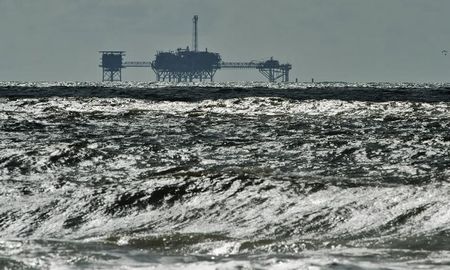By Swetha Gopinath and Sayantani Ghosh (Reuters) - Advances in drilling technology are reviving the prospects of oil companies in shallow parts of the Gulf of Mexico, helping to squeeze more from older fields while the U.S. shale bonanza lures others onshore.
Apache Corp and a handful of smaller independent companies are using seismic surveying and horizontal drilling - techniques perfected during the onshore fracking boom - to tap mature fields and find hidden reserves on the shelf.
The methods appeal to investors hungry for the quick profits that cannot be delivered by deepwater drilling, where a dozen years of planning and billions of dollars in investment can be required to get oil pumping.
The technology, already used successfully by Apache in the North Sea, has revealed oil and gas reserves that were previously hidden in water less than 500 feet (150 meters) deep.
"3D seismic has not only helped us in acquiring new leases with new reserves on them, but also in sharpening targets for development drilling in our existing fields," Andy Clifford, president of Saratoga Resources Inc, told Reuters.
Replacing reserves and increasing production has long been a challenge on the Gulf of Mexico shelf. The easy-to-find oil has already been drilled, resulting in a drastic fall in production.
But the use of seismic data, much more precise than previous mapping techniques, is tempting geologists to take a second look for new fields and re-evaluate older deposits to see what might be left behind.
After an unusually harsh winter, higher prices for natural gas - abundant on the shelf - are an added incentive to drill.
"We are re-shooting all of our large fields to make sure that we haven't missed anything," said Matt McCarroll, chief executive of Fieldwood Energy LLC, a private equity-backed company that bought shelf assets from Apache and SandRidge Energy Inc last year.
Total proved reserves in the Gulf of Mexico are currently about 4.9 billion barrels of oil equivalent (boe), according to the U.S. Energy Information Administration.
But Stephen Trammel, an analyst at market research firm IHS, said some estimates peg reserves at nearly 10 times this amount.
With a market value of $1.8 billion, Energy XXI Ltd is worth a fraction of Apache or any of the oil majors, but has grown to become a big presence on the Gulf shelf since it deployed horizontal drilling and seismic tools.
Energy XXI's proved reserves, which are mostly to be found off the Louisiana coast, jumped by 50 percent in 2013 alone.
John Schiller, the company's founder and chief executive, said Energy XXI had extracted 5 percent of its reserves in the Gulf of Mexico and expected technology to squeeze out a further 5 percent.
"That's a meaningful number when we talk about 6 billion barrels of oil in place underneath our top 10 fields," he said. Even at a 5 percent recovery rate, the company would be able to produce 300 million barrels of oil.
'INVISIBLE' NO MORE
Horizontal drilling, which allows companies to set up miles-long pipes through a single rock formation, can deliver up to 20 times the production of wells tapped by vertical drills.
The technology is not entirely new. Companies in the Gulf of Mexico have been drilling horizontally for about two decades, though with limited results compared with developments onshore.
When twinned with recent advances in seismic tools, the biggest advantage of horizontal drilling today is its ability to identify the maximum amount of oil and gas in rock formations.
New seismic tools involve using sound waves that allow drillers to "see" oil and gas trapped in rocks through high-resolution 3D images.
"The best place to find oil and gas is where you know it already exists," said Michael Breard, a research analyst at Hodges Capital, a Dallas-based investment advisory firm.
Production in the shallow waters of the Gulf of Mexico more than halved in the last decade to 534.8 million boe in 2013. Trammel said he expects production to turn the corner, and soon.
Apache is among the companies likely to drive that growth. Despite selling assets worth more than $10 billion in the last year, primarily to focus on shale, it has kept 50 percent of the unexplored portions of shelf properties it sold to Fieldwood.
Thomas Voytovich, chief operating officer of Apache's international operations, says new drilling techniques have led the company to previously "invisible" parts of the Gulf.
"We are not going to be doing anything in the deep water in the foreseeable future," he said. "Most of the prospects that we are developing right now are literally in jack-up rig territory, which is 300 feet or less."
Jack-up rigs - mobile platforms with a floating hull - were the one bright spot in rig contractor Diamond Offshore Drilling Inc's recent quarterly results. Revenue from its deepwater business declined.
Shallow-water wells are also cheaper. Using infrastructure left over from earlier drilling, they can be installed for about $10 million; a deepwater well would cost upward of $50 million.

The returns, so far, have been good. Each of Saratoga's three horizontal wells are yielding double to triple the initial production of vertical wells. Seismic technology is helping the company to drill deeper, said Clifford.
"It's all about getting more bang for your buck," he said.
(Editing by Robin Paxton)
